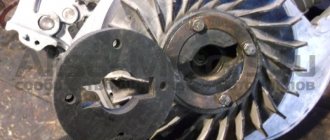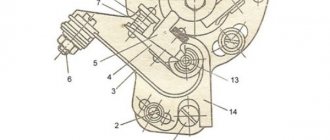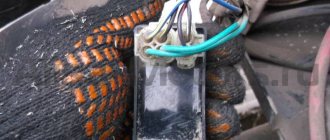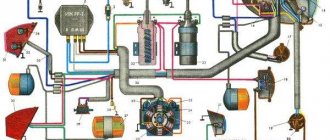How to set the ignition on a 4t scooter? Problems with ignition of a 4-stroke engine can appear for various reasons, but they all lead to the same result - the engine stops starting. But the lack of a timely spark may not be the only reason that the engine does not start. To make sure that it is the ignition that is causing the engine failure, it is necessary to check all other possible faults that may interfere with engine operation and eliminate them. Breakdowns may occur in the ignition system, the causes of which can arise from both the mechanical and electrical side. Using simple techniques, you can determine whether the problem is a mechanical fault or an electrical component. At home, you can fix any breakdown in the ignition system of a 4-stroke scooter engine.
Reasons for failure of a 4-stroke scooter engine
If the scooter engine does not start, there can be a variety of reasons: 1. There is no fuel supply to the combustion chamber. 2. Air supply is not adjusted. 3. There is no compression. Burnt and deformed valves do not provide compression. The reason for the lack of compression may be incorrect assembly of the cylinder-piston group, as well as a malfunction of the cylinder itself. 4. The gas distribution mechanism responsible for the operation of the valves is faulty. 5. The spark plug is faulty. 6. An ignition spark is not produced during the mechanical operation of the generator.
How to set the ignition on a Honda Dio When choosing, pay attention to the presence
Ignition on Audi Alexander Category: Setting the ignition of the Audi 80 is carried out according to 3 marks: Then, designed specifically for asphalt, the car, along with certain basic cars, began the new era of parquet jeeps. For the base we took the Honda Civic, and the name of the car itself stands for Comfor. 2 Honda Dio 27 fit the ignition coil. How to set the ignition Look at the color of the commutator wire, you can find it in the commutator connector.
Remove the protective cap from the ignition switch. Select the wires that go to the ignition switch.
The wire that matches the color of one of the wires that goes to the switch is the wire silencing the scooter. It remains to determine the purpose of 2 wires - from the electromagnetic sensor and from the supply coil.
The black wire with a red stripe is usually from the electromagnetic sensor, the second is from the supply coil. The ignition timing on the scooter does not start. Honda Dio 27 won't start Video.
How to set the ignition on a Honda Dio scooter
Scooter ignition system, diagram, operation, clearly, in simple language - accessible to beginners. Knowing the principle of operation. Elsheep-Team Honda Accord 8. In any case, it is positioned that way.
One of the standard configurations has a very extensive audio system.
How to correctly adjust the ignition on a VAZ Most car owners who have a VAZ car may have encountered difficulties associated with the correct operation of the engine. A common problem is that turning the engine key starts it, but the engine does not respond correctly to idle ignition.
The principle of operation of the ignition on a 4-stroke scooter engine
Ignition on a 4t scooter depends on the synchronous movement of the gas distribution shaft located in the cylinder head and the magneto. There is a protrusion on the outside of the rotor housing that contacts the ignition sensor during rotation. At the moment of contact, a spark appears on the spark plug. The rotor is connected to the crankshaft. At the moment the spark occurs, the crankshaft and piston are in the extreme dead center position. How to set the ignition on a 4t scooter? It is necessary that during the passage of the dead center the position of the gas distribution shaft corresponds to the moment of ignition of the fuel in the combustion chamber.
How to set the ignition on a 4t scooter? Operating principle, causes of malfunction and setup
Operating a scooter and enjoying its ownership brings a lot of positive emotions to the owner. In general, a scooter is a truly unique motor scooter, which is an almost universal transport. The scooter is great for driving around the city and for traveling outside of it. And everything would be fine, but sooner or later the moment comes when it has to be repaired and maintained, something that motorcyclists like to do much less of. Also, you often have to adjust and set the ignition, which few people know how to do correctly. It’s exactly how to set the ignition on a scooter that will be discussed in today’s article.
Adjusting the ignition of a 4t scooter
In order for the rotation of the generator rotor and gas distribution shaft to correspond to the desired piston operating cycle, it is necessary to set their position according to the marks. On the magneto body there is a marker for the position of the dead center of the cylinder in the form of the letter “T”. The rotor can be adjusted manually, or using a kick starter. The position of the camshaft is determined by the marks on the timing sprocket. Three points marked on the star from the outside form an equilateral triangle, the vertex of which should be directed to the extreme position from the piston. Adjusting the ignition consists of setting the correct position of the timing star.
Ignition advance
How to set the ignition on a 4t scooter with advance? There is an opinion that if you do this, the speed and power of the motor will increase. In theory, this is true. If the spark at the moment of compression occurs slightly before the moment the cylinder passes the dead center, this should give the desired effect. But the technical implementation of such an ignition setting on a scooter is associated with the transfer of its protrusion on the generator rotor housing. There is a method that is simpler and safer, which gives a certain effect. You can make a step on the ignition ledge. To do this, you need to remove a layer of 0.5 mm from half the surface of the protrusion. The step should start from the side that first contacts the ignition sensor. The resulting dual spark will provide more predictable engine starting and will also increase the likelihood of ignition when exposed to adverse weather conditions and improper fuel and air settings.
What is ignition and how does it work?
So, let's start getting answers. The ignition system in a scooter is responsible for the correct operation of its engine and the appropriate moment of ignition of the mixture of fuel and air. The required proportions of these components are provided in the carburetor, and then the combustible composition enters the cylinder. At the moment of the highest degree of compression, a spark is supplied to the spark plug, which ignites the mixture. The spark voltage in some engines reaches 40 thousand volts.
The ignition system of a scooter is responsible for ensuring all this; it has a similar principle of operation in a moped, walk-behind tractor and any other mechanical vehicle with a gasoline engine. The result of its correct operation are such characteristics as a quick increase in engine speed, the usual level of exhaust gases emitted from the pipe and the absence of suspicious pops.
If suddenly, after repairs, you sit on your own “iron horse”, and for some reason it no longer gallops with the agility inherent in it, it’s worth checking the spark plugs. They must have a light brown soot. If the spark plugs have a black, tarry, thick layer, this is not a good symbol; in general, any deviation from the norm may be evidence of a malfunction of the ignition system.
Read
A sure sign of a poorly adjusted mechanism is also a slow increase in engine speed, exhaust pipe shots, and excessive smoke density.
While driving, you may experience jerking and uneven acceleration when accelerating. Any one of these signs or a composition of several is a direct indicator of a malfunction of the ignition system; in most cases, this problem is solved by adjusting it.
The principle of operation of ignition in a 4-stroke scooter engine
Modern scooters are equipped with contactless systems. They are considered the most reliable and easy to use, do not require complex connections, and provide a constant good spark on time. However, the setting is still important; even the presence of a spark does not always allow the fuel mixture to ignite, since its power also plays a role.
The main reasons for the operation of the ignition system are quite simple: its task is to create a spark to detonate the fuel mixture. If this does not happen, you need to carefully examine each node and find out why the spark disappeared.
- In order to check whether there is a spark at all, you need to unscrew the spark plug and apply it to the engine ground; this can be done using metal objects that are not covered with paint. You cannot hold it with your hand: if there is a spark, it can give you an electric shock, and the discharge reaches 40,000 volts, which the coil creates.
Broken ignition is the cause of engine failure
An incorrectly configured or faulty ignition often causes engine failure. It would be wrong to immediately climb into the cylinder and examine the insides of the scooter, especially since this will not solve the problem. Before touching the ignition system, you need to check for other reasons why the scooter may not work.
- The simplest thing is the lack of gasoline in the tank. Quite often, owners forget to refuel their vehicle, and such a trivial reason can be overlooked.
- The carburetor may be clogged, which prevents the formation of a mixture suitable for driving.
- The carburetor needs to be cleaned regularly, so it doesn't hurt to check whether fuel is flowing from it into the cylinder. It is possible that the fuel pipe is clogged. The jets and other parts of the device may become clogged with debris, which causes little fuel to flow or, conversely, the engine does not have enough air, and therefore it does not start.
- The scooter may also refuse to start if the fault is caused by spark plugs. They may be wet or not produce a normal spark. It is advisable to have a spare set and check with it. In any case, the spark plug needs to be unscrewed and inspected.
What is ignition and how does it work?
So, let's start getting answers. The ignition system in a scooter is responsible for the correct operation of its engine and the appropriate moment of ignition of the fuel-air mixture. The required proportions of these components are provided in the carburetor, and then the combustible composition enters the cylinder. At the moment of maximum compression, a spark is supplied to the spark plug, which ignites the mixture. The spark voltage in some engines reaches 40 thousand volts.
Ensuring all this is precisely what the scooter ignition system does; it has a similar operating mechanism in a moped, walk-behind tractor and any other mechanical vehicle with an internal combustion engine. The result of its correct operation are such indicators as a rapid increase in engine speed, a normal level of exhaust gases released from the pipe and the absence of suspicious pops.
If suddenly, after repairs, you sit on your “iron horse”, and for some reason it no longer gallops with the former agility inherent in it, it stands. They should have a light brown soot. If the spark plugs have a black, tarry, massive layer, this is a bad sign; in general, any deviation from the norm may be evidence of a malfunction of the ignition system.
How to set the ignition on a scooter
With minimal experience, but good theoretical knowledge, you can set the ignition yourself. To do this, you just need to strictly follow the instructions below.
The most important part of tuning is to find the correct position for the timing sprocket to sit. In order to find it, they use special marks that are applied at the factory during engine assembly. The desired mark looks like the letter "T". In this position, the piston is at dead center. This is the extreme position after which the piston will return back. You need to rotate the rotor until the protrusion on the crankcase and the letter “T” coincide. This can be done using your hands or a kick starter. An electric starter does not need to be used.
If the piston has only moved down minimally, turn it further until the marks line up. It's not always possible to get the right position the first time. After they match, you need to study the other marks: they are located on the timing star. Usually these are three points or holes that are located on the outside of the star. They form a triangular shape if you connect them visually. Notice that one point is larger than the others. After adjusting the ignition, it should be on top, and the other two marks should remain opposite each other. They must stand horizontally.
If the ignition is contactless, it is adjusted as follows. In order for the engine to run smoothly and correctly, you need to adjust the ignition of the mixture at the right moment. To do this, after all the tags are installed in the right places, you need to understand how the contactless principle works in general.
A special feature of the BZS is the presence of special sensors, a switch, and two types of ignition coil winding. When the sensor is closed using a rotor equipped with a magnet, a pulse is generated that enters the commutator, it pumps up the current coming from the generator and directs it to the primary winding of the coil. After this, the charge enters the secondary winding, where a high voltage is generated, with the help of which a spark appears, used to detonate the gasoline mixture. Adjusting the ignition is the alignment of the marks on the crankcase and the star. Usually you have to remove the valve cover.
How to set the ignition on a scooter
Many people ask about how to set the ignition on a 4T scooter. In fact, this process is not as complicated as it seems at first glance, because all you need is a screwdriver and marks. In order to adjust the ignition on a scooter, you need to set the timing star position correctly. In our task we will be helped by special marks that have already been placed by the manufacturer at the factory.
Pay attention to the magneto housing. There should be a special mark on it in the form of the letter “T”. It is this mark that indicates the dead center of the cylinder (the extreme position of the piston in the cylinder when it reciprocates). Based on this mark, you need to align the rotor so that the mark on the rotor coincides with the “T” mark on the magneto housing. To do this, crank the kick starter with little effort or move the rotor manually.
Then, you will need one more, last mark located on the timing star. This mark consists of three holes or points that are marked on the outside of the timing sprocket. These points subsequently form a triangle, where one of the points or holes is the largest. After you adjust the ignition, the largest hole should be at the top, and the other two points should be opposite each other in a horizontal position. You can see more details on how to set a tag on a 4t scooter in the video below.
What is advance ignition
The quality of the mixture supplied to the engine cylinder determines the behavior of the scooter in cold weather, as well as how high the wear of the cylinder itself will be. For example, with a rich mixture, the engine starts better, but carbon deposits form; with a lean mixture, the cylinder quickly wears out and traction is lost.
In order to facilitate the process of starting the engine, you can set the ignition to advance, this will make it easier to start the engine regardless of the weather outside, slightly increase engine power, and significantly increase traction. The peculiarities of such settings are that a charge is formed in the spark plug before the piston reaches the dead center. This makes it easier to start the engine and increases engine power. However, it is worth remembering that cylinder wear may increase.
The procedure is carried out in approximately the same way as a regular ignition adjustment, but has its own nuances. To do this, all the same actions are carried out, only the tags are not completely connected. The discrepancy should be approximately half a centimeter. This is enough to get the desired effect.
How to set the lead angle (video)
Ignition advance
Some motorcyclists who understand proper ignition settings prefer advanced ignition settings. If we talk about this process more simply, then with this ignition, the motorcycle engine has a little more power and starts much easier. The thing is that with ignition set to advance, the spark plug produces a spark a little earlier than the piston in the cylinder reaches top dead center. Thus, we get a small increase in power and easier starting in bad weather conditions, for example, during cold weather.
Answering the question of how to advance the ignition on a 4T scooter, we can say that this is no more difficult to do than a normal setting. If you are already familiar with how to set marks on a 4t scooter and how to set up the ignition itself, then you will not have any difficulties. All you need to do is not completely connect the marks on the rotor and magneto housing. About half a centimeter is enough to get the ignition to advance.
This completes the ignition adjustment on the scooter. As you can see, there is nothing difficult here, the main thing is to connect all the marks correctly.
About adjusting the ignition of a 4t scooter
Knowing how to set up the ignition of a 4T scooter on your own, you can save time and money, since you will not need to contact a motorcycle repair shop. The procedure is simple, even if you have no experience it takes a little time, but you will need to be patient. Regardless of the type of ignition, an important role is played by how the marks are set.
Correct adjustment is a guarantee of stable and smooth engine operation even in cold weather conditions. Often, in used vehicles, the ignition is broken: this can happen for various reasons, ranging from elementary shaking when driving to improper handling of the equipment. In order for the scooter not to let you down and for you to be able to start it whenever you want, you will need to learn how to carry out this procedure yourself. To do this, you will need to have several keys that allow you to remove the valve cover if the engine is four-stroke.
Setting up the Vision scooter ignition system
If the ignition is knocked out, this may be the reason the scooter does not work. Restoring it is not difficult if you understand how it is done.
Advice: before starting work, carefully check and clean the carburetor: this may be the reason. Adjust the quality of the mixture. In addition, it doesn't hurt to check the spark plugs.
You need to start adjusting by setting the timing belt in the desired position. As a rule, there are marks on it for this purpose; they are set at the factory. The cylinder must be installed at dead center. The mark may be indicated by the letter T or another symbol. Now make sure that the mark installed on the rotor matches the mark found on the magneto. To do this, you need to gently press the kickstarter. The rotor can also be turned using your hands, but this is more difficult.
There are also marks on the timing star in the form of holes or dots; they must be set so that the largest hole is on top and located exactly in the center. The remaining points should be below and located horizontally opposite each other. Setting the ignition advance makes sense if you want to increase the engine's power a little and make it start easily. The adjustment will help make the spark plug produce a spark earlier than the standard time. That is, a spark will appear even before the piston reaches the dead center. In cold weather, a moped configured in this way will start better.
In order to configure the scooter in this way, you will need to repeat the procedure described above. However, there is a difference: the marks should not coincide clearly, and not reach each other by about 0.5 cm. The main difficulty lies in connecting the marks.
Scooter ignition advance
Ignition advance is a shift of several degrees in the timing of the spark at the spark plug before the engine piston reaches top dead center (TDC). When ignited, a combustible mixture of fuel and air does not explode instantly, as many believe, but burns - this combustion takes some time. The engine will operate more efficiently and economically when the maximum pressure from the explosion of the burning fuel mixture occurs immediately after the piston passes TDC, i.e. when the piston begins to move downwards. To do this, you need to ignite the combustible mixture before the piston reaches top dead center. Ignition timing in electronic CDI - switches - of modern scooters is not adjustable, but is completely controlled electronically.
But to check the timing of the ignition installation, some modern scooter models have measuring marks. To check the ignition timing of a scooter you need a special device - a strobe light. Such a device is not included in the tool kit of a regular scooter, and its purchase should not be considered absolutely necessary - the average scooter rider will rarely use it.
How does a strobe light work? A strobe is a device in which a bright light flashes at the moment a spark “shoots” in a candle. By determining the ignition moment with a strobe while the engine is running (the light flashes at the moment of ignition), you can see the dimensional marks and determine whether they are in the right places relative to each other. Such risks are located on the flywheel of the scooter generator and counter risks are on the housing next to the flywheel. But not all scooter models have these risks, and therefore in this case the strobe light will not help here.
Since ignition timing is determined for a certain crankshaft speed, some stroboscopes are equipped with a speed sensor - take this into account when purchasing a device if you still need it. If the crankshaft speed is not regulated, this usually means that the test must be carried out with the engine idling. In this case, first you need to find out whether the idle speed corresponds to the regulated characteristics of the scooter. The strobe is connected in accordance with its manufacturer's recommendations. A regular strobe has three wires, two of which are power, the third is connected to the spark plug wire. Some scooter manufacturers do not recommend or prohibit connecting the strobe light's power to the electrical network of the scooter itself - otherwise the readings will be incorrect; This may be due to small surges in the load on the power supply during the strobe flash. The check is carried out on a warm engine.
To check the ignition timing of a scooter, you need to point the strobe light at the synchronization risks - they must completely or almost completely coincide. In the most undesirable case, the marks on the flywheel are located at a considerable distance from the corresponding marks on the body during strobe flashes, or are not visible at all. The electronic ignition system of a scooter, for all its advantages, is inconvenient in the sense that the average scooter owner cannot check it, therefore, if the scooter’s ignition timing is incorrect, a trip to the workshop is the only correct method to find out the cause. Ignition system parts are not cheap, so they are difficult to replace on the basis of “Isn’t it broken?” You can, of course, try replacing parts if someone you know has a similar scooter whose parts can be used. Pitfalls of the metropolis for a beginner on a “stool” Useful tips for a scooterist Drawing of a variator puller A scooterist’s “alarm suitcase” Problems with a scooter Dictionary of technical terms Scooter’s dictionary Compression ratio, engine compression, and octane number Oil for two- and four-stroke engines Tire markings, speed index table and tire loads Scooter ignition advance Scheme of the simplest switch, without electronic advance Caucasian injection Electric scooter? History of the scooter LED lights for the scooter Helmet, glasses and contact lenses A survival guide for motorcyclists
Conclusion
Don't be afraid of the ignition system. It’s easy to set up, the main thing is to check the entire circuit; much more often the switch fails, there is no gasoline or the spark plug needs to be replaced. Only after making sure that there are no physical malfunctions should you start setting up the ignition. If it is set correctly, you will hear and notice, as the engine will start easily and run smoothly.
Often, scooter owners need to set the ignition. In this article we will talk about how to properly adjust the ignition and in what cases this procedure should be carried out.
So, what can indicate that the ignition on a scooter is not configured correctly? Typically, the following signs may indicate problems with ignition:
— The engine is trembling, that is, it is working unstably (extraneous uncharacteristic sounds are heard, vibration is felt, floating speed is noticeable at idle); — Popping noises are heard in the muffler; — Power drops; — The scooter smokes more than usual; — The engine does not pick up speed well.
If you observe one or more of these signs, then it is worth checking the operation of the ignition system. A good place to start is by checking the spark plug. As a rule, the appearance of the spark plug can shed light on the reasons for the engine's malfunction. You need to pay attention to the color of the end of the insulator that goes into the cylinder. During normal ignition operation, it has a sandy tint. If the end of the insulator is black, then this indicates that there is soot on it, and this is a reason to figure out whether everything is in order with the ignition.
Before taking a closer look at the process of setting the ignition, it is necessary to briefly touch upon the principle of operation of the ignition itself. Actually, unstable engine operation can be observed with premature and late ignition. With premature or early ignition, the fuel-air mixture is ignited by the spark plug at a time when the piston is not yet at top dead center. With late ignition, the fuel-air mixture is ignited when the piston is almost down, that is, the mixture ignites and passes through the exhaust rings of the cylinder, which leads to pops and smoke from the muffler. The optimal moment for ignition - ignition of the fuel-air mixture occurs at the moment the piston begins to move from the dead center down. This is a very specific figure, which is usually indicated in the scooter’s operating instructions. Typically, the amount of downward displacement of the piston at which the best ignition timing occurs is from 2 to 4 mm.
It is worth noting that there are two types of ignition - contact and non-contact. They all produce a spark, but their operating principles are different. Contact ignition is based on a mechanical interrupt system. However, this type of ignition is considered obsolete and is practically not used on modern motorcycles. Today, most modern scooters use a non-contact ignition system, which is based on the operation of a sensor, switch, primary and secondary ignition windings.
To set the ignition on the contact system, you first need to disassemble the crankcase. Then on the contact group you need to set the maximum allowable gap for a full circle of shaft rotation. Next, you need to set the piston to the distance from the dead center specified in the scooter's operating instructions. Then you should loosen the stator fastening and adjust it until the contact closes. Next, we assemble the crankcase in reverse order.
To set the optimal moment for a spark on a scooter with a contactless ignition system, you must first disassemble the crankcase. Then you need to make a mark on the crankcase and rotor at the position of the top dead center of the piston. In this case, the spark plug must be unscrewed. After which it is necessary, by turning the shaft, to record the moment the spark appears. Next, we make another mark on the crankcase. Thus, the distance between the two marks is a very important parameter, which is usually called ignition timing. The distance between the two marks gives us the so-called ignition advance. Now you need to loosen the bolts on the generator stator and set the ignition to the level specified in the scooter's operating instructions.
Setting the ignition on the scooter
How to properly set the ignition on a scooter
Before you set the ignition on a scooter, you should understand what is happening inside the engine. Otherwise, maybe the person never looked inside, or, if he did, he didn’t think about the process itself.
What may indicate that the ignition is set incorrectly? One of the following symptoms is enough to suspect something is wrong. The engine runs unevenly, lacks power, so-called popping noises may be present, smokes too much, and does not pick up speed well. True, it is not yet a fact that the ignition is to blame. In any case, you should unscrew the spark plug. The color of the end of the insulator, which directly enters the cylinder, should ideally be sandy. If it is black and smoky, then you should start adjusting the ignition. Although, perhaps, it is not its fault. But you have to start somewhere to look for improper engine operation. There is no fundamental difference in adjusting the ignition in the engine of a scooter, moped, motorcycle, lawn mower or chainsaw.
The process of setting the ignition is not complicated, but it is responsible. Ignition may be early - this is the case if the fuel-air mixture is ignited by a spark plug when the piston has not yet reached top dead center. The piston moves upward, and the expanding gas is already hitting it. Agree, it's a bad situation. Ignition can also be late, this is when the piston has already moved far down from top dead center. In this case, the mixture may ignite as it passes through the exhaust ports of the cylinder. It’s also bad - those same “pops” or smoke. The correct moment to ignite the mixture is when the piston has only minimally moved down from top dead center. Typically, this value is indicated in the equipment manual and ranges from two to four millimeters. Depending on the engine design.
Ignition can be contact or non-contact. The contact one is installed on older models of motorcycles and mopeds, so we won’t talk about it. Anyone interested can find it online on their own. Modern scooters are equipped with contactless and electronic systems.
If in a contact system the current is interrupted mechanically, by closing or opening the circuit, then in a contactless system the principle of operation is slightly different, although they are similar. In any case, the low voltage electric current is generated by the generator. When the rotor closes the sensor, the latter sends a signal to the commutator. And it begins to accumulate electric current in the primary winding. Thanks to electromagnetic induction, a current with a high voltage appears in the secondary winding, sufficient to cause a spark in the spark plug. The point of adjustment is to ensure that the spark appears at the right moment.
First you need to disassemble the crankcase. Make a mark on the crankcase and rotor at the top dead center position of the piston. And then, turning the shaft, wait for a spark to appear. Naturally, at this moment the candle must be unscrewed. We make another mark on the crankcase. The distance between the two marks gives us the so-called ignition advance. We loosen the bolts on the generator stator and set the ignition as indicated in the technical manual for the scooter.
Determining the top dead center of the piston is simple. Insert a stick, a sliver, or a strip of thick cardboard into the hole from the unscrewed candle. And slowly rotate the shaft. The stick rises and falls. The highest rise gives us top dead center. Carefully mark it with a pencil. If you don’t have an instruction manual at hand, you can act on a whim. Take out the stick and mark a line on it, located two to three millimeters above the previous one. Insert the stick back into the engine and unscrew the piston these two to three millimeters below. Set the spark to appear in this position.
Source: Moto Scooter











